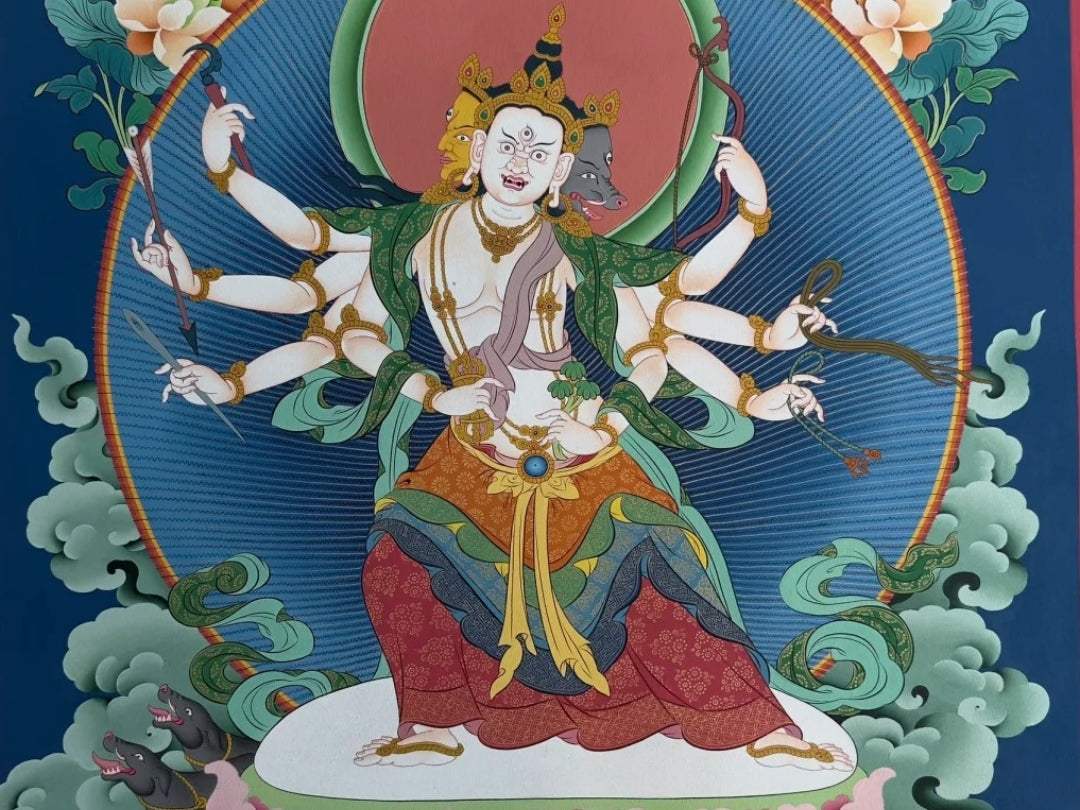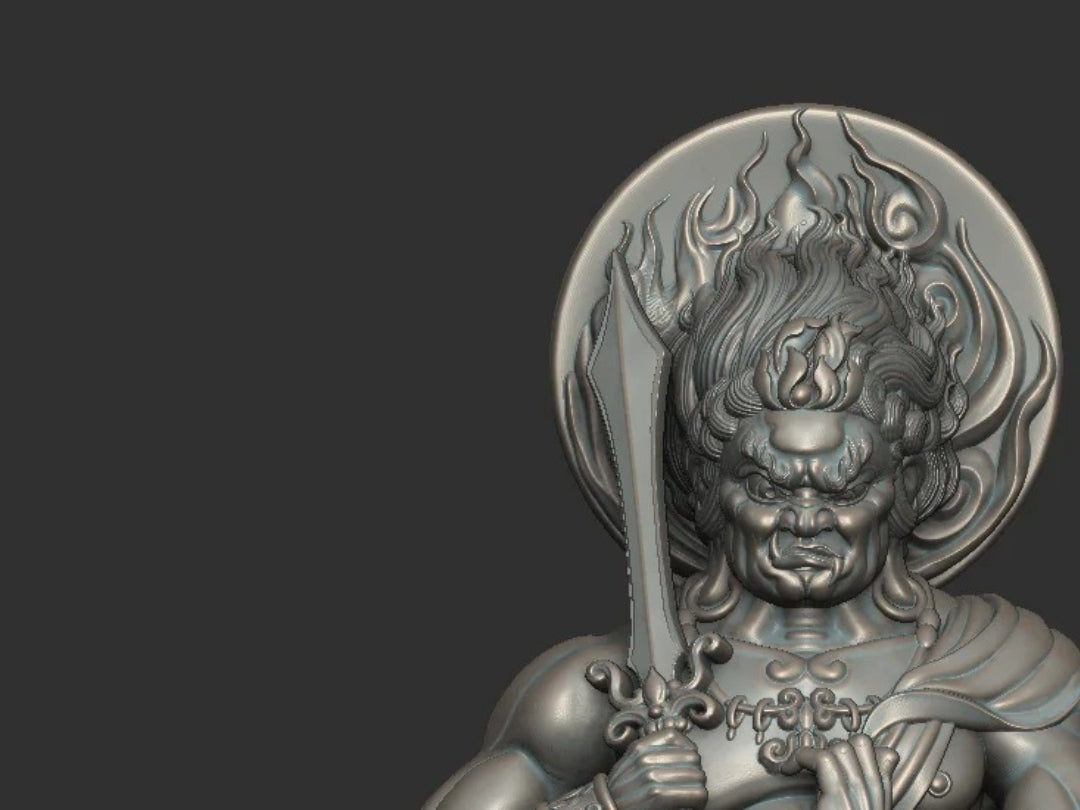In Tibetan Buddhism, Marīcī (摩利支天) is revered as a powerful protector deity, renowned for her ability to vanish at will and remove obstacles from the lives of practitioners. Originally a Sanskrit goddess associated with light (“marīta” meaning “ray” or “shine”), Marīcī’s presence in Vajrayāna reflects a fusion of Indian and Tibetan traditions. In this article, we explore her origins, iconography, and spiritual significance—along with how Tibetan Buddhist jewelry and protection amulets draw inspiration from her timeless energy.

Origins and Cross-Cultural Roots
-
Early Indian Roots
-
In Vedic lore, Marīcī appears as a radiant, pig-headed goddess associated with the dawn—riding the waters of the Ganges as the mount of various deities.
-
The pig’s head motif (often linked to local water spirits or dolphins) symbolized her dominion over darkness and the transformative power of sunlight.
-
-
Adaptation into Tibetan Buddhism
-
As Buddhism spread northward, Marīcī was embraced by Tibetan practitioners. She took on a unique multi-armed form, combining her original light-bearing role with the dynamic qualities of a Vajrayāna protector.
-
In her fully awakened form, Marīcīdevī may be depicted with three faces and six or eight arms, sometimes with one face in the shape of a fierce boar—signifying her ability to ward off ignorance and danger.
-
She is often shown riding a golden pig (or a chariot drawn by seven or nine pigs), illustrating both her connection to earthly forces and her unstoppable momentum across the sky.
-
Iconography and Symbolic Meaning
1. Faces and Arms
-
Three Faces:
-
One serene, one boar-like (with tusks), and one wrathful. Each face represents a different aspect of Marīcī’s power—compassion, fierce protection, and transcendent wisdom.
-
-
Six or Eight Arms:
-
Commonly holding symbolic implements:
-
Lotus (Padma): Purity and spiritual awakening.
-
Vajra (Dorje): Unbreakable force, representing indestructible compassion.
-
Bow and Arrow (Dhanus-Bāṇa): Precision and the power to strike through obstacles and negative forces.
-
Staff or Noose (Pāśa): Capturing distractions and guiding beings toward the path of light.
-
Vajra-axe (Phurba): Cutting through delusion.
-
Needle (Sūtra) and Arrow: Often associated with healing or puncturing illusions.
-
-
2. Pig and Chariot Motif
-
The golden pig mount signifies Marīcī’s mastery of terrestrial energies. Pigs in early Indian tradition symbolized abundance of water and earth, while in Tibetan contexts they also represent resilience and the capacity to transform.
-
A chariot drawn by seven or nine pigs underscores her speed in protecting practitioners from harm and guiding them toward safety, even when riding the very element associated with chaos.
3. Radiant Light and Hidden Power
-
Marīcī’s name literally means “ray of light.” In Buddhist iconography, she often stands before or atop the rising sun—symbolizing the dawn of wisdom and the dispelling of ignorance.
-
Legends describe her as so luminous that even the sun god (Sūrya) cannot perceive her. This ability to become invisible underscores her protective role: she shields practitioners from both seen and unseen dangers.

Functions: Protector, Invisibility, and Disaster Removal
-
Invisibility and Stealth
-
Considered the ultimate master of concealment, Marīcī can render beings invisible—both to natural and divine eyes.
-
Practitioners invoke her to move undetected through adversities, whether physical dangers or malicious energies.
-
Famous among medieval Japanese ninja and samurai, who adopted her as a guardian to grant them stealth and success in battle.
-
-
Disaster Removal (Extirpation of Obstructions)
-
Marīcī’s power extends to preventing or dispelling calamities—such as fire, flood, illness, and demonic interference.
-
In Tibetan monasteries, images of Marīcī are placed near entrances to protect temple grounds from natural disasters and negative influence.
-
When reciting her mantra or performing her ritual, practitioners seek safety, prosperity, and overall well-being.
-
-
Warrior-Protector Aspect
-
Known as a “guardian goddess of war,” Marīcī arms herself with symbolic weapons to defend the Dharma.
-
In her more wrathful depictions, she brandishes a flaming sword to sever delusion, shattering enemies of the mind.
-
Though fierce in appearance, her anger is always directed at liberating sentient beings from suffering—emphasizing her dual role as both nurturer and fierce defender.
-

Marīcī in Practice: Mantra, Mudra, and Ritual
-
Essential Mantras
-
The most common invocation is the Marīcī Purvavideha Mantra:
-
Chanting this mantra is believed to invoke her protective power, promoting invisibility from harmful forces and fostering inner strength.
-
-
Mudras and Visualizations
-
Mudra of Concealment: One hand may form a fist at chest level, symbolizing locked energy—representing Marīcī’s ability to conceal and protect.
-
Mudra of Blessing: Another hand extends downward, fingers splayed, offering blessings to all beings.
-
-
Ritual Implements
-
Protection Amulets: Marīcī’s image is stamped or engraved onto metal plates (thog cha), carried in wallets or tucked into clothing.
-
Thangka Depictions: Monastery thangkas of Marīcī, often painted with metallic gold pigments, are displayed to bless entire regions.
-
Daily Practice: Visualizing Marīcī at dawn, bathing in first light, reminds practitioners of the daily opportunity to transform ignorance into wisdom.
-
Marīcī’s Influence Beyond Tibet
-
Japan
-
Introduced in the Tang Dynasty, Marīcī (known as Kōmyōten or “Goddess of the Sun’s Rays”) became popular among samurai as the “mist goddess” for granting victory.
-
Ninja used her mantra and mudras to practice stealth (particularly in dense forests and dim light).
-
Shrines to Kōmyōten remain in some Japanese temples, where martial arts students seek her blessing.
-
-
Modern Adaptations
-
Contemporary martial artists (e.g., ninjutsu practitioners) sometimes recite her mantra before training.
-
In New Age and esoteric circles, Marīcī’s “invisibility” is interpreted as a metaphor for dissolving emotional blocks or gaining clarity in times of confusion.
-

QiLing Aura’s Marīcī-Inspired Jewelry and Amulets
At QiLing Aura, we honor Marīcī’s timeless power by incorporating her image into protective jewelry and amulets—carefully handcrafted to resonate with her energy.
-
Miniature Marīcī Thangka Pendant
-
Thangka medallion inside a Ga Wu box—rendered in reds and golds to invoke Marīcī’s radiant light.
-
-
-
A finely engraved S925 silver ring depicting Marīcī’s three-faced, six-armed form.
-
Each face (serene, boar, wrathful) is micro-engraved inside the ring frame.
-
By wearing these pieces or placing them on your altar, you invite Marīcī’s blessings into your daily life—calling upon her to remove hidden obstacles, shield you from misfortune, and illuminate your path with inner light.
How to Pray and Recharge Your Marīcī Amulet
-
Dawn Invocation:
-
At first light, hold your Marīcī pendant and recite her mantra (e.g., Om Rāṃ Rāgilillāghaṃ avatūṭe mahāmāyī svāhā) three times. Visualize her as a golden sunrise, enveloping you in protective rays.
-
-
Tibetan Bell Resonance:
-
Use a small Tibetan bell (ghanta) to purify your amulet. Ring the bell five times as you hold the jewelry over the sound vibration—believed to clear any accumulated negative energies.
-
-
Moonlight Cleansing:
-
On a full moon night, leave your Marīcī-inspired piece on a windowsill or altar to bathe in the moon’s glow. The lunar energy is said to recharge its protective potency.
-
-
Sage or Cedar Smoke:
-
Gently pass your amulet through the smoke of burning sage or cedar, invoking the power of elements to cleanse and renew its charm.
-
Conclusion
Marīcīdevī stands as a timeless guardian in Tibetan Buddhism, embodying the powers of invisibility, disaster removal, and unwavering protection. By understanding her layered iconography—three faces, multiple arms, boar-headed features, and radiant light—you gain insight into her profound role in the Vajrayāna path.
At QiLing Aura, our Marīcī-inspired jewelry merges ancient symbolism with modern artistry—crafting miniature amulets and Tibetan Buddhist jewelry that carry her protective energy into everyday wear. Whether you seek subtle spiritual shelter or a bold statement of divine light, Marīcī’s presence in these handcrafted pieces invites you to live with greater courage, clarity, and peace.
Embrace Marīcī’s blessings today. Invite her light to shield you from unseen dangers, clear obstacles, and guide you through life’s darkest corners—knowing she rides the dawn, forever outpacing even the sun itself.



